Home University of Edinburgh Library Essentials
July 26, 2024
The University of Edinburgh Art Collection: Irene G. Thomson, Anne Marie Gilmore and Gwen Hardie
Posted on September 29, 2023 | in Uncategorized | by lbeattieAsh Mowat is one of our volunteers in the Civic Engagement Team. Inspired by Katy Hessel’s ‘The Story of Art’, Ash has been looking into the work of three female artists whose work belongs to the University of Edinburgh’s Art Collection. Find out more about these artists below as well as how to search our online art collections database or how to view artworks in our reading room. [Content note: pictures included contain nudity]
Introduction
The University of Edinburgh’s Art Collection contains almost 8,000 individual pieces of art which represent the combined historic University of Edinburgh Fine Art Collection, with Edinburgh College of Art holdings. In this blog, I will look at the work of three different artists from the collection. Whilst doing so, I will endeavour to give an insight into how to search and view art works in the University’s Art Collection using the online catalogue and the reading room. I will comment on the experience of searching for and viewing items on the website, and also viewing some of the works in person at the University of Edinburgh to help anyone else who might wish to do so in future.
I should make it clear that whilst I dabble in art myself, it is largely for the pleasure and therapeutic benefits as I’m certainly no professional artist. Neither do I possess any academic expertise in the visual arts, so my notes here are those of an interested and enthusiastic observer, rather than that of any kind of expert.
In selecting items to view, I focused on contemporary artists who studied at the Edinburgh College of Art from 1960s to 1980s. This was partially as this era can be viewed as an early period of greater accessibility to study at degree level, given that it predated tuition fees and included wider support services such as non-repayable living maintenance grants and Housing Benefit etc., available to those from lower income families.
As someone who is currently enjoying reading The Story of Art (without men) by Katy Hessel,[1] I chose to include women artists only, given the historical tendency for visual arts to focus on male artists. Furthermore, the artists I’m featuring are largely not famous or well-known individuals, as I find it is exciting to explore some works and their creators that may not get so much attention elsewhere.
Searching the Collections
The online catalogue of the University of Edinburgh’s Art Collection can be found at: University of Edinburgh Art Collection. A simple search of artists by name will bring up details of any of their works held. In some instances, the dimensions of the artworks are included. The media used to create individual items is sometimes noted (e.g. oil paint). There isn’t any detailed biography of the artists featured. Some of the items in the collection have been digitised and their entries contain an accompanying photograph.
Other than searching by artist name (correct spelling required), you can enter a specific year date or era such as 1980 or 1980s to narrow your focus. This function is not always precise, however. For example if searching for 1980 you will be shown works that date from that exact year, but it will also capture works from other years in the same decade. Equally, if searching for 1980s it will generate work from that decade but also select items from 1880s or earlier centuries.
The artist Irene G Thomson
There are three works by this artist included in the collections. One of the works pictured below (‘Portrait of a man with a book’) has been digitised and is listed as being a composition crafted using oil paints. I like how its thickly applied and dramatic brush strokes still serve to brilliantly capture the features and expressions of the sitter. The subject is holding but not reading a book, and is gazing perhaps wistfully to one side, as if quietly reflecting on something. I enjoyed the composition, character of the sitter and the textures and contrasting areas of light and dark that we encounter. (For clarity I should note that my reflections on this work as based on viewing the digitised image only on the University’s collection website, not having seen the painting in person).
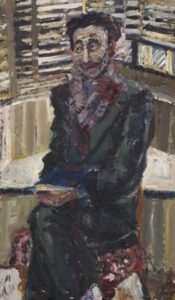
Irene G Thomson
Portrait of a man with a book (c.1950s-60s)
Oil paint
EU3210
© the artist[2]
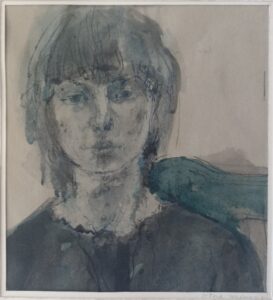
Irene G Thomson
Untitled: Portrait of a female with fringe (1963-64))
Portrait in pen and ink wash
EU4184
© the artist[3]
I was able to view the portrait above at the Centre for Research Collections (CRC) located in the University of Edinburgh Main Library. The portrait itself is sized 18 x 16 cm composed onto paper and mounted but unframed. In terms of colours, it is chiefly in monochrome in varying shades from black to grey, with accents of aquamarine around the eyes, skin tone and background. The sitter’s features are well executed despite the fluid challenges of the media, with a thoughtful gaze expressively rendered.
I like the contrast between areas of finer detail such as the eyes and looser work on the clothing. The grey green hues and dripping lines on the hair give the impression somehow of an image caught in reflection against either water or glass.
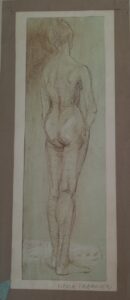
Irene G Thomson
Untitled: Standing nude female (1963-64))
Figure drawing in conte, graphite and white chalk
EU4183
© the artist[4]
I was also able to view the above drawing by the same artist, sized at approximately 35 x 10 cm. In what was probably a piece created during a short single viewing of the model, this sketched standing nude figure is very well captured. The varying tones from the use of graphite and then white chalk help create and establish detailed anatomical features, and muscle and skin surfaces and densities. Viewed from the back, we do not see the model’s face as instead the focus and detail is in on the limbs, head and neck, delivering a fine depiction of an elegant, relaxed and poised figure.
I was not able to access a wider biography of the artist, only dates provided that the obtained their degree at the Edinburgh College of Art in 1963, with a postgraduate completed the following year.
Ann Marie Gilmore
Ann Marie Gilmore (1948-2006)[5] was a Canadian artist who studied at the Edinburgh College of Art in the late 1960s and early 1970s. She worked using a variety of media but from the late 1970s focused on the use of watercolours to create her art. She became a friend of fellow artist Richard Demarco[6] who described her flower paintings as having “a particular gift of expressing her delight in nature through a joyous use of colour”.
She travelled extensively and taught at for a period back in her native Canada before dedicating her time as a full time artist, with her vibrant watercolours using a combination of abstract and figurative styles to great effect, capturing landscapes, flowers, portraits and architectural observations.
Sadly she died all too young whilst only in her fifties, with the two pieces held by the University of Edinburgh kindly provided by her family.[7] Her brother Professor Bill Gilmore remarked:
“Ann Marie studied at the Edinburgh College of Art in the late 1960s and early 1970s. Though then an independent institution, dating back to 1760, it has recently merged with the University of Edinburgh. Her works now join an impressive and extensive collection which includes pieces by some of those who taught her and others with whom she studied”.
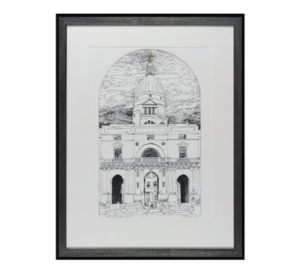
Ann Marie Gilmore
The Old Quad, Edinburgh (1985)
Ink/Coating 49 x 64 cm
EU5144
© the artist[8]
I was able to view on request this piece in the University of Edinburgh library. Its subject is an impressive and historic structure at the heart of the campus of the University.[9]It clearly made an impression on this artist, as it would likely impact upon many students coming to make their home in Edinburgh.
This is a highly intricate and finely detailed work executed in ink, brilliantly capturing the many refined architectural features, stonework and archways encountered at the main entrance into the quadrangle. Surprising to discover that at the time of this art being composed that the elegant lawns now present were once used as a car park. Mercifully the aesthetics of the feature have been restored to remedy this.
The exquisite detailing is further enhanced by outstanding use of the sharply contrasting areas of bright light set against the deep, dark archways and windows, creating a three dimensional effect. The loosely rendered figures in the courtyard and background make way for the star of the piece, the Old Quad building itself.
The artwork is complemented by a matching arched mount, mirroring the towering dome at the centre of the composition. The work is finished by a fine border of gold, and also gilded is the statue of Golden Boy at the crown of the piece.
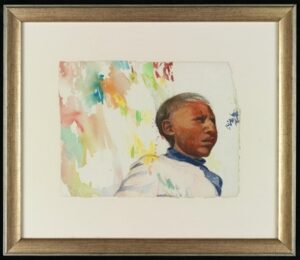
Ann Marie Gilmore
Andean Boy, Edinburgh (circa 1983)
Watercolour 26 x 19 cm
EU5143
© the artist[10]
I was not able to view this work in person so am using the image provided on the University of Edinburgh Art Collection online catalogue. This small piece is only 10x 8 inches in diameter unlike the larger pieces that the artist was to later favour, although it is in watercolour, which remained her favoured media throughout her artistic career.
Presumably painted during her years of travel, the portrait places all focus on the child’s face which is well defined, given the media used, with a looser accent of bright colours for a background. Seemingly peering into the sun his eyes are narrowed, and the white expanses of the piece and skin tones brilliantly represent the impact of the blazing sunlight in the Andes. The artist also manages to convey the child’s serene expression.
Gwen Hardie
Born in Fife Scotland in 1962, Gwen Hardie[11] completed a first class honours degree at the Edinburgh College of Art in 1983, followed by a postgraduate diploma with distinction the next year. She has lived and worked as an artist in Berlin, London and across America, having been based in New York since 2020.
Whilst only aged in her early twenties, in 1994 she became the youngest living artist to have been granted a solo exhibition at the Scottish National Gallery of Modern Art in Edinburgh.
The artist has demonstrated a flair and expertise in a wide variety of styles,[12] moving from her earlier precise and figurative portraits and draughtsmanship into her current non-figurative work, such as her “Squares” series.
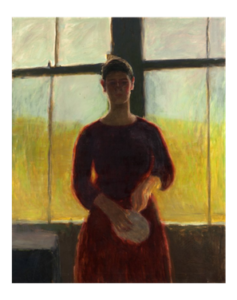
Gwen Hardie
Self Portrait against Window 9circa 1983)
Oil on Canvas 152 x 122 cm
EU3148
© the artist[13]
I wasn’t able to view this work in person due to difficulties in arranging these for larger pieces. Completed during her period studying art as an undergraduate, it may well have been undertaken in the Edinburgh College of Art building, as it features as a backdrop their recognisable impressively large windows that allow light to flood the studios. There is a clever mirroring and intertextuality here as she is holding a palette in the piece, reflecting both the subject and creator as artists.
She has elected to keep the face in a lot of shadow accounting for the background light source, but up close we do get an impression and expression of her features, and the highlighted edges around her head and face help deliver a strongly developed portrait. The colours are lovely warm hues that shift and blend creating textures and features.
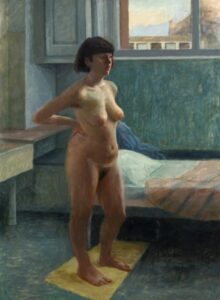
Gwen Hardie
Nude in Sunlight 1983
Oil on Canvas 167 x 122 cm
EU3148
© the artist[14]
Once again I had to rely on kindly consented use of a digital image to view the painting given its scale. In this work we have an oil on canvas portrait of a standing nude woman. The model’s skin tones are brilliantly finished, a highly crafted and refined study of the human form, but equally non-photographic in its use of blurring and intermingling colours to create depth, perspective and areas of light and shadow. The model’s confident stance possibly suggests the artist’s use of the female gaze, and gives the subject a powerful and dignified presence.
Whilst the artist’s current works referred to earlier as non-figurative paintings, one aspect that she has continued to demonstrate is as love for colour. Her recent works, such as the squares series, whilst abstract, are not blocks of uniform colour: but instead they appear to pulse, shimmer and breathe, and are mesmerising to view.
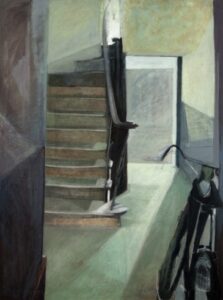
Jean B.M. Lothian
Stairway (circa 1979)
Oil on Canvas 137 x 183 cm
EU3191
© the artist[15]
Finally to finish with a painting from an artist that I’ve not been unable to source any biography for.
I therefore do not know if the artist continued to work in the field or not, but I thought it was fitting to end with a lesser known artist. Its subject is unspectacular, almost quotidian in nature, but acts as a slice of life for the then and now: the almost ubiquitous dwelling for many students, the Edinburgh tenement stairwell replete with bicycle.
It has muted but not monochrome tones, utilising the chiaroscuro: the sharply varying areas of light and dark in the composition. The different material of stone, wood and steel in the piece are accented differently to give texture and reflected light.
In conclusion I would urge anyone with an interest in the arts to explore the University of Edinburgh Arts Collection. If doing so please do not publish any images without prior consent, and if granted ensure to correctly attribute the source of images.
I should like to thank University of Edinburgh staff for allowing access to view works and use images from the collection. I should particularly like to thank Liv Laumenech for their generous time with guidance and corrections, and also to Laura Beattie, my Engagement Officer (Communities) supervisor at the University of Edinburgh.
[2] “Portrait of a Man with a Book” (ed.ac.uk)
[3] https://collections.ed.ac.uk/art/record/99420?highlight=irene+g+thomson
[4] https://collections.ed.ac.uk/art/record/99419?highlight=irene+g+thomson
[5] Ann Marie Gilmore Fine Art – Home (amgilmorefineart.com)
[6] https://en.wikipedia.org/wiki/Richard_Demarco
[7] Ann Marie Gilmore’s Art Enters Edinburgh University’s Permanent Collection – Ann Marie Gilmore Fine Art (amgilmorefineart.com)
[8] https://collections.ed.ac.uk/art/record/99917?highlight=anne+marie+gilmore
[9] https://en.wikipedia.org/wiki/Old_College,_University_of_Edinburgh
[10] https://collections.ed.ac.uk/art/record/99916?highlight=anne+marie+gilmore
[13] “Self Portrait against Window” (ed.ac.uk)
Collections
 Archival Provenance Project: Emily’s finds
My name is Emily, and I’m the second of the two archive interns that...
Archival Provenance Project: Emily’s finds
My name is Emily, and I’m the second of the two archive interns that...
 Archival Provenance Project: a glimpse into the university’s history through some of its oldest manuscripts
My name is Madeleine Reynolds, a fourth year PhD candidate in History of Art....
Archival Provenance Project: a glimpse into the university’s history through some of its oldest manuscripts
My name is Madeleine Reynolds, a fourth year PhD candidate in History of Art....
Projects
 Sustainable Exhibition Making: Recyclable Book Cradles
In this post, our Technician, Robyn Rogers, discusses the recyclable book cradles she has developed...
Sustainable Exhibition Making: Recyclable Book Cradles
In this post, our Technician, Robyn Rogers, discusses the recyclable book cradles she has developed...
 Giving Decorated Paper a Home … Rehousing Books and Paper Bindings
In the first post of this two part series, our Collection Care Technician, Robyn Rogers,...
Giving Decorated Paper a Home … Rehousing Books and Paper Bindings
In the first post of this two part series, our Collection Care Technician, Robyn Rogers,...
